Concrete Mix Ratio for a Sidewalk
What is the Ideal Concrete Mix Ratio for a Sidewalk? Creating durable sidewalks requires the use of high-quality concrete mix with the right ratio of ingredients. The concrete mix ratio plays an essential role in ensuring the longevity and strength of a structure. PSI (pounds per square inch) strength of the concrete surface you need usually determines the ratio you use. Basic concrete mixing ratios for sidewalks are 1:2:3, 1:1.5:3, and 1:2:3. These ratios show the proportion of cement, sand, and stone. Table of Contents Importance of Right Concrete Mix Concrete is made from a blend of cement, water, sand, and aggregate (gravel or crushed stone). Ideal mix ratio for a sidewalk helps achieve the compressive strength that withstands weather variation and occasional vehicle load. Such concrete has a smooth and slip-resistant surface that doesn’t prematurely crack, chip, or damage. Concrete Ratio for a Sidewalk Slab For compressive strength of 3000 or 4000 PSI, concrete ratios of 1:2:3 or 1:1.5:3 are used. This translates as 1 part cement mixed with 2 or 1.5 parts sand and 3 parts aggregate. To mix these ingredients together, water is added. Usually a water-to-cement ratio of 0.5 (half the amount of water as cement) is ideal for balance with strength and workability. Role of Each Ingredient in the Concrete Mix Each ingredient in the concrete mix ratio has a specific role, including: Cement Cement acts as the binding agent. When mixed with water, it forms a paste that coats the aggregate particles and creates a strong bond. For sidewalks, Portland cement is commonly used because of its durability and ease of use. Sand Sand fills the gaps between the aggregate particles and contributes to the density and strength of the concrete. Fine sand is usually a preferable choice for sidewalk repair to achieve a smoother surface. Aggregate Aggregate usually consists of crushed stone and gravel. It provides volume and enhances the concrete strength. Aggregate used on the mix must be clean, durable, and appropriately sized to fix the thickness of the sidewalk. Water Water activates the cement and enables it to harden. The amount of water must be controlled carefully to avoid making the mixture weak. Too much water dilutes the cement paste, makes it prone to cracking, and reduces the overall strength. Adjustment for Climate and Weather Conditions You might need to adjust the concrete mix based on local climate or specific environmental considerations. For example, during the curing process, if concrete is exposed to freezing temperatures, it can lose its strength. In such a situation, using a mix with higher cement concrete or adding an accelerator to speed up the curing process can be an efficient choice. Similarly, during hot climatic conditions, temperature can cause the concrete to set too quickly and make it challenging to achieve a smooth finish. A mix with a slightly higher water-to-cement ratio can improve workability. However, it is essential to not exceed the recommended ratio, as it will compromise the strength. Conclusion Choosing the right concrete mix ratio is crucial for constructing a sidewalk that is safe, durable, and aesthetically pleasing. A 1:2:3 or 1:1.5:3 ratio with a water-to-cement ratio of around 0.5 will generally produce strong and long-lasting concrete that will stand up well to foot traffic, weather exposure, and occasional vehicle loads. However, adjustments of the ratio may be needed based on climate, local codes, and other conditions.
Importance of obtaining
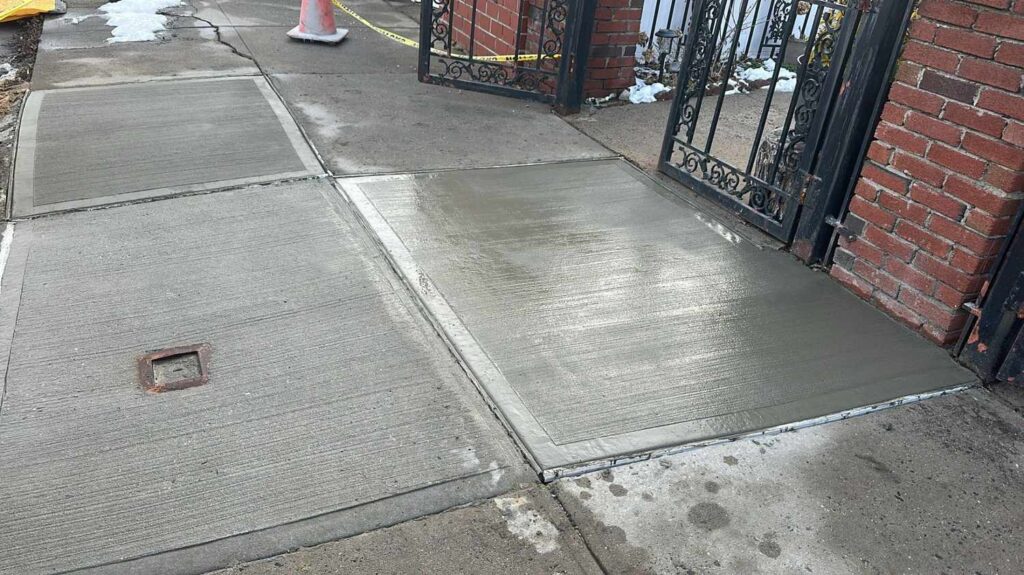
Obtaining a Sidewalk Repair Permit for Historic Landmarks The majority of NYC’s historical landmarks are public property, and they are in charge of maintaining their structural integrity. Sidewalk repairs, among other maintenance tasks for these buildings, are essential and need your immediate attention. However, any modification necessitates obtaining a sidewalk repair permit from the Landmarks Preservation Commission (LPC). Let us explore why obtaining this permit is essential and what benefits it brings to the owners, residents, and the city’s historical integrity. Table of Contents What are NYC’s Historic Landmarks and Preservation Rules? Historic landmarks are designated buildings, sites, or structures recognized for their cultural, historical, or architectural significance. LPC was established to preserve these historic sites. Any renovation, alteration, or repair to these landmarks, including surrounding sidewalks, requires approval from LPC. Failure to acquire a permit for any maintenance project can result in fines, delays, and possibly irreparable damage to the area’s historical context. Why is a Sidewalk Repair Permit from LPC Necessary? There are many reasons why getting a repair permit from LPC for sidewalks around historical landmarks is essential. Let us look at them. Preservation of Historical Integrity Sidewalks around the landmarks are often constructed using materials that match the historical period of the building or site. Similarly, in some cases, these sidewalks themselves hold historical value. An LPC permit ensures that the modifications to the sidewalk are made by using the approved material and align with the original design. Compliance with Landmark Preservation Laws LPC monitors and enforces landmark preservation laws and ensures the repair or renovation is per the landmark’s character. Obtaining a sidewalk repair permit allows you to adhere to these laws and ensure that your project complies with city regulations. Avoiding DOT Violations NYC DOT is responsible for ensuring sidewalk safety. DOT will issue a violation notice if the sidewalk adjacent to the historical building is damaged. Addressing this issue without DOT and LPC permits can lead to penalties and additional violations. With a proper sidewalk permit, you ensure that your repairs meet the standards of both departments. Professional Oversight When you apply for the sidewalk permit at LPC, they provide professional oversight for the project. It ensures that the repair work you perform is per approved guidelines and maintains the historical accuracy of the building and the safety of pedestrians. Hiring licensed sidewalk contractor can also help you with your sidewalk projects. They apply for these permits on your behalf because they understand their importance. By trusting them, you can comply with city regulations, prevent any legal problems or delays in work, and redo the same job again. How do you apply for an LPC Sidewalk Repair Permit? Applying for a sidewalk repair permit from LPC consists of a step-by-step process. Before submitting the permit application, the first step is to contact LPC and understand the specific requirements for the sidewalk adjacent to your landmark. After defining the scope of work, apply for the LPC. The application will require information, including detailed plans for the repairs, materials being used, methods of repair, and the estimated timeline.After applying to get a permit, LPC will review the application to ensure the proposed work will maintain the site’s historical integrity. They will issue the necessary permits if your repair plan meets their standards. Conclusion Getting a sidewalk repair permit for historic landmarks in NYC is a legal requirement and a responsibility to maintain the city’s rich history. If you own a historical landmark, get an LPC permit for sidewalk repairs and preserve your property’s beauty and historical significance while complying with city codes. The permit will not only make your sidewalk safe and accessible but will also save you from potential fines and legal liabilities.
Can a broken sidewalk be repaired free?
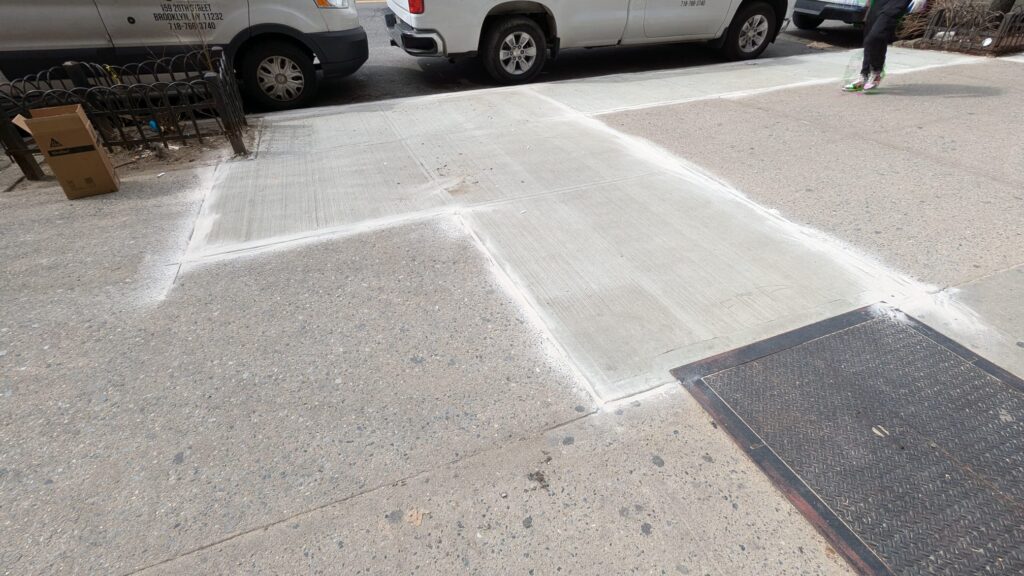
Can a Broken Sidewalk be Repaired for Free in NYC? For most property owners, the answer is no. It is the owner’s job to fix broken sidewalks, which costs money. However, if the roots of a city-owned tree have damaged your sidewalk, the Trees and Sidewalks Repair Program might be able to help. This program is designed to help property owners lessen the cost of fixing damage caused by city trees. What is the Trees and Sidewalk Repair Program? The Trees and Sidewalks Repair Program is a city initiative the NYC Parks Department manages. Its primary goal is to address the damage caused to sidewalks by city-owned trees, particularly in residential areas. Table of Contents Eligibility for Free Repairs Eligibility for the Trees and Sidewalks Program typically applies to one-, two-, or three-family homes with damage that can be traced back to the roots of city trees. It’s essential to act promptly and document the damage to ensure you are following the appropriate procedures. Key Features of the Program: Inspection Requests: Property owners can request an inspection of their sidewalks if they believe city tree roots are causing damage. This is the first step in the process. Prioritisation of Repairs: The Parks Department receives thousands of inspection requests annually (approximately 9,000). They prioritize repairs based on several criteria, including: The severity of the damage Amount of pedestrian traffic in the area Size and condition of the tree While the program aims to address sidewalk safety, it’s important to note that even homes located in high-priority areas may experience lengthy wait times for repairs, sometimes lasting up to three years. What to Do if a Tree is Damaging the Sidewalk? If a city tree is damaging your sidewalk, follow these steps to seek a resolution: Request an Inspection: Contact the NYC Parks Department through 311 helpline or their website to request an official inspection of the sidewalk. You can do this online or by contacting their offices directly. Ensure you provide clear details and any documentation related to the damage. Wait for Evaluation: The Parks Department will evaluate the damage and assess whether it meets the Trees and Sidewalks program criteria. Consider Self-Repair: Given the potential wait time, many property owners choose to repair the sidewalk themselves. If you go this route, you must take specific steps to comply with city regulations. Steps for Self-Repair and Reimbursement If you decide to undertake the repairs yourself, follow these guidelines: Obtain a Tree Work Permit: Before starting any work within 50 feet of a city tree, you must obtain a tree work permit from the NYC Parks Department. The application process usually takes about 45 days, and the permit will be valid for 90 days once issued. This step is crucial to ensure compliance with city regulations. Hire a Licensed Contractor: It’s advisable to hire a licensed contractor experienced in sidewalk repairs. They can help ensure that the work meets city standards and minimizes potential damage to the tree. Make Repairs: After securing your permit and hiring a contractor, proceed with the repairs. To avoid any issues, ensure that you follow all guidelines provided with the permit. File for Reimbursement: Once the repairs are completed, file a claim with the NYC Comptroller’s Office within 90 days. To successfully claim reimbursement, you’ll need to provide a checklist of required documents, which may include: The permit for tree work Invoices and receipts for the repair work Photos of the damage and the completed repairs Documentation Checklist: Tree Work Permit Detailed invoices from the contractor Receipts for materials used Before-and-after photos of the sidewalk Navigating the process may feel stressful, but it’s essential to keep sidewalks safe and accessible for all New Yorkers. Adequately maintained sidewalks enhance neighbourhood aesthetics and contribute to pedestrian safety. Conclusion In a nutshell, while sidewalk repairs in NYC typically fall to property owners, those affected by city tree roots can seek assistance through the Trees and Sidewalks Repair Program. For others, taking on repairs independently can be a viable option, however with its own set of regulations and procedures. By understanding the available options, homeowners can ensure that their sidewalks remain safe and inviting for all pedestrians. You can visit the NYC Parks Department and the NYC Department of Transportation websites for more information. If you need further assistance, consider contacting local resources or a reputable contractor in nyc for guidance. Keeping our sidewalks in good condition is a shared responsibility that benefits the entire community.
5 Inexpensive ways to transform your Concrete Patio

5 Inexpensive Ways to Transform Your Concrete Patio Concrete patios can be used for different purposes but homeowners do not always put them to good use. It can be because of their lack of character or visual appeal. If you’re looking to refresh your outdoor space without spending too much money, there are several budget-friendly ways to transform your concrete patio into a stylish and inviting area. Let us discuss five inexpensive methods through which you can revamp your patio. Outdoor Rugs Placing a rug over your concrete patio is the quickest and most inexpensive way to add color, texture, and pattern to the surface. You can find the rugs in any style, size, or material that best suits your budget and taste. Whether you like a bold geometric design or a natural jute look, an outdoor rug is an efficient way to transform your concrete patio into a warm, cozy, and inviting space. Expert Tip: You may need to secure the rug with a clip to prevent it from shifting in windy conditions. Cost: Outdoor rugs vary in price depending on size and quality. You can find small rugs for as little as $20, while larger, more durable options may cost between $50 and $150. Table of Contents Tile Installation For a more permanent solution, consider installing tile on your concrete patio. Tiles offer endless design possibilities and can give the structure a more sophisticated look. You can use ceramic, porcelain, and natural stone tiles over concrete, as they are not only durable but also weather-resistant and easy to clean. Expert Tip: Take professional help in the installation process, as DIY can be difficult and time-consuming. Moreover, without proper knowledge, you might not be able to install complex patterns. Cost: The cost of installing tiles typically ranges between $3 and $10 per square foot, making. Build a Deck Over Your Patio If you want to elevate your patio, consider building a deck over your concrete patio. A deck adds warmth, character, and versatility to your outdoor space. You can choose from a variety of wood types, including cedar, redwood, and composite. Expert Tip: Adding a deck requires proper drainage and ventilation. Therefore, you must take professional help in the installation process to avoid any issues in the future. Cost: Adding a deck over your patio can cost between $3 and $20 per square foot. The cost can vary based on the type of wood, as Brazilian walnut decks can be expensive. Transform with Concrete Resurfacing Concrete resurfacing is a cost-effective way to give your patio a fresh look without completely replacing it. This process involves applying a new layer of concrete or a specialized overlay to the existing surface. You can choose from various finishes, colors, and patterns to create a unique and customized look. Expert Tip: For your resurfacing project, ask for professional help, as they have a better idea about the materials that can be used and the techniques to provide efficient repairs. Cost: Average cost of resurfacing your concrete is around $3 to $5 per square foot. It can vary based on the design of the concrete patio. For intricate designs, you might have to invest more money. Install Plants Bring nature into your outdoor space by adding plants to your patio design. Potted plants, hanging baskets, and raised garden beds can add color, life, and privacy to your patio. Choose plants that thrive in your climate and complement your overall design aesthetic. Expert Tip: Keep in mind to regularly water your plants and give extensive care to them to avoid insects. Cost: The cost of potted plants varies depending on the size and type of plant you choose. Small potted plants typically start at around $10, while larger planters with mature plants can Conclusion Transforming your concrete patio doesn’t have to be expensive. With a little creativity and some budget-friendly materials, you can turn your outdoor space into a beautiful and inviting area for relaxation and entertainment. Whether you choose to stain your concrete, add some potted plants, or incorporate a rug to the surface, these inexpensive methods can breathe new life into your patio and make it a space you’ll enjoy for years to come.
Best Methods to Repair Cracks in Concrete Sidewalks
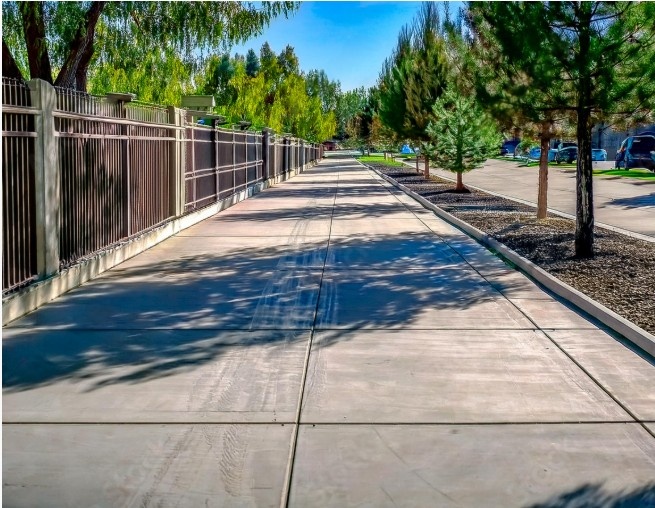
Best Methods to Repair Cracks in Concrete Sidewalks Concrete is the most durable and long-lasting material. It has the ability to withstand heavy foot traffic and extreme weather conditions. However, due to its porous properties, it absorbs moisture and other chemicals gradually. Due to the temperature fluctuation, the moisture freezes in winters and expands, which exerts pressure on the adjacent slabs, leading to developing cracks. On the other hand, concrete itself has the properties to expand and contract. When the temperature rises more than 50 degrees Celsius, the concrete expands. As a result, it exerts a lot of pressure on the adjacent slabs, potentially leading to cracked surfaces. Addressing them promptly can help prevent them from becoming worse, avoiding more severe structural issues. Adopting the right repair method is important to save time, money and energy while ensuring long-lasting results. The following are some of the most effective methods for repairing concrete sidewalk cracks. Table of Contents Epoxy Injection It is a practical and efficient way to repair cracks as small as 0.05 mm or 0.002 inches. It involves Setting up venting and entry ports closely together Fixing the fissures on exposed surfaces Pressurized injection of epoxy Epoxy injection demands a high level of expertise for effective application, and it may not work well in very hot or cold weather. Additionally, if the root cause of the crack is not addressed, new cracks are likely to form near the original location. At higher temperatures, epoxy resins experience a significant reduction in strength. Epoxy injection is not the suitable method if the cracks are active and in large numbers. Routing and Sealing of Cracks The most effective, quickest, and easiest ways to repair cracks are routing and sealing. They are efficiently used when just remedial repair is required without the need for structural repair. It involves Enlarging the crack through its exposed face Filling and sealing crack with a suitable joint sealant Compared to epoxy injection, this technique is the most efficient and works well for both large, isolated cracks and fine pattern cracks. Epoxies, urethanes, silicones, polysulfides, asphaltic materials, and polymer mortars are some of the materials used as joint sealants. This treatment reduces moisture’s ability to reach the reinforcing steel or penetrate the concrete, resulting in surface stains. Crack-filling Compounds Several types of crack-filling compounds are available for various types of cracks. The type of crack and environmental factors determine what compound is used to fill it. The following are some examples of compounds used to fill cracks in concrete sidewalks. Hydraulic Cement A quick-setting substance called hydraulic cement is used to patch and fill concrete cracks. When exposed to water, it quickly sets and hardens, making it appropriate for repairing structural cracks and leaks. The process involves: Mix it in water to make a fine paste Apply it to the cracks after thoroughly cleaning the area Smooth it out with trowel to get a clean finish Despite being used to repair major cracks larger than ¼ inch, it cures quickly and offers a strong, long-lasting repair that is not limited to hairline cracks or sealing. Acrylic Sealants Acrylic sealants are water-based compounds that fill cracks in concrete surfaces. They are easy to apply and offer a smooth and shiny surface. The process involves: Clean the area to get dust-free surface Apply the sealant with the caulking gun Smooth it out with the trowel Acrylic sealants are moderately durable and suitable for less-trafficked areas. They provide a good sealing layer against the moisture, but in high-traffic areas it might be required to have a reapplication to ensure more durability in the long run. Polyurethane Sealants Polyurethane sealants are flexible, long-lasting substances used to repair concrete cracks in sidewalks. They offer excellent adhesion and resistance to weathering and UV radiation. The process of fixing the cracks involves Thoroughly clean the cracked surface Apply the sealant with the help of the caulking gun Smooth it out with trowel to get clean and finished surface They are extremely durable and perform exceptionally well in a variety of environmental conditions, retaining their flexibility and integrity over time. Conclusion Cracked sidewalks are not just eyesores but also dangerous for pedestrians, creating significant trip hazards. They become worse, leading to more severe structural issues and sidewalk violations if left unaddressed. Seeking professional assistance to repair minor or larger cracks promptly can help reduce safety risks while also improving the aesthetic appeal of the sidewalk.
How Can DOT Sidewalk Violations Affect Your Property Value in New York?
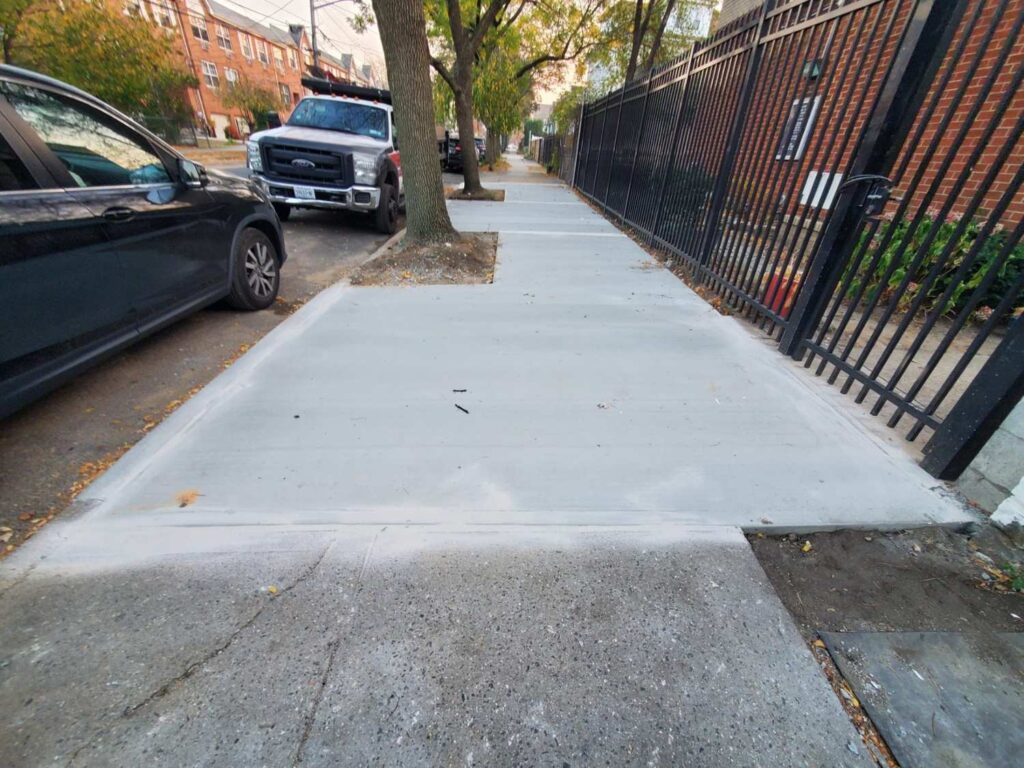
How DOT Sidewalk Violations Affect Property Value Sidewalks play a vital role in providing well-maintained and safe pathways for pedestrians. They enhance the aesthetic appeal of the neighborhood as well as the property as well. In NYC, the sidewalks are strictly inspected, not only by the DOT for the sake of pedestrian’s safety but also by the insurance company during the process of obtaining homeowners insurance. A sidewalk violation might be more than just a notice or a legal hassle. It can also diminish the property’s market value and the buyer’s appeal towards the property when its time to sell that property. Table of Contents The Role Of Sidewalk in Property Appeal and Value Well-maintained sidewalks contribute to the property’s overall curb appeal. They create a safe and visually appealing environment, enhancing the accessibility and functionality of the property. For residential properties, sidewalks are the first feature perspective the buyer notices, setting the tone for the rest of the property. Commercial properties facilitate foot traffic and attract customers, directly influencing business revenue and property desirability. When sidewalks are cracked, uneven, or poorly maintained, they not only pose safety hazards but also reduce a property’s aesthetic and functional value. Sidewalk violations exacerbate this issue by flagging the property as non-compliant, potentially deterring buyers and reducing its attraction in the real estate market. Decrease Curb Appeal Cracked or damaged sidewalks create a negative first impression. For potential buyers, visible sidewalk damage can signal neglect, leading them to question the property’s overall maintenance. This perception can reduce the actual value of the property, resulting in lower offers. Increase Repair Cost Sidewalk violations require property owners to make the repairs within a specified time of 75 days. Failing to address these violations can result in fines and additional penalties, which increase the financial burden on the owner. Buyers may hesitate to invest in properties that require immediate repair or may negotiate lower prices to offset anticipated expenses. Legal Liabilities and Insurance Properties with sidewalk violations can become legal liability for owners. If a pedestrian is injured due to damaged sidewalks, the owner may face personal injury lawsuits that could be the fine and the 10-day prison or both. This risk can significantly deter the buyers and lower the property’s value in the market. Reduce Property Demand Sidewalk violations are publicly recorded and can deter potential buyers during the property appraisal process. Mortgage lenders and real estate agents often review the violation history of the properties, and unresolved issues can make it harder to secure financing or attract competitive offers. Impact on Commercial Properties For commercial properties, sidewalk conditions directly influence customer perception and foot traffic. Damaged sidewalks can deter customers and reduce business revenue, making the property less attractive to investors or business owners looking to lease or purchase. The Broader implications of Sidewalk Violations Beyond the financial and aesthetic impacts, sidewalk violations can contribute to a decline in neighborhood appeal. When one property has poorly maintained sidewalks, it can encourage surrounding properties to neglect maintenance as well, leading to a downward spiral in neighborhood standards. This collective decline can result in lower property values across the board. The Broader implications of Sidewalk Violations Beyond the financial and aesthetic impacts, sidewalk violations can contribute to a decline in neighborhood appeal. When one property has poorly maintained sidewalks, it can encourage surrounding properties to neglect maintenance as well, leading to a downward spiral in neighborhood standards. This collective decline can result in lower property values across the board. Conclusion Sidewalks play a crucial role in maintaining the city’s infrastructure as well as providing a safe and accessible path for everyone. When they get caught in the violations, they not only create safety hazards for the pedestrians but also a lot of consequences for the homeowners. They impact the overall curb appeal and market value, as well as create hindrances for obtaining personal insurance. Remember, taking prompt action can not only help you make the city sidewalks accessible and safe but also help prevent the legal consequences. Conducting routine inspections, maintenance and prompt repairs is important to preserve the integrity of the sidewalks.
5 Most Common Sidewalk Repair Challenges
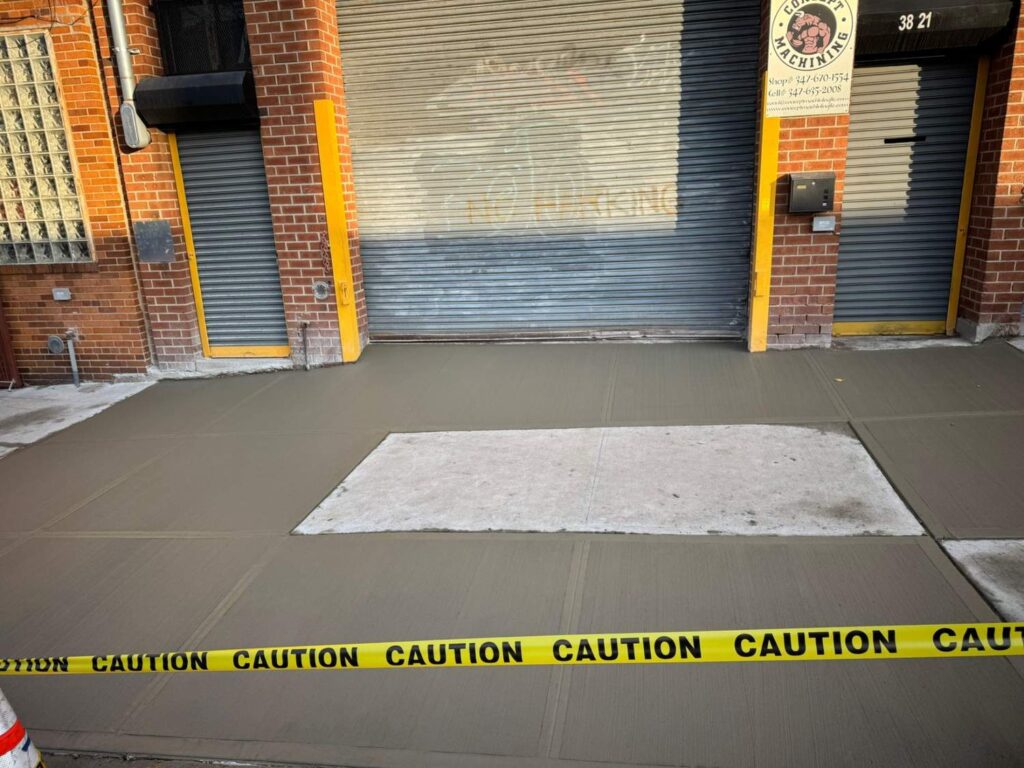
5 Most Common Sidewalk Repair Challenges Sidewalks must be maintained to ensure safe, clean and accessible paths for everyone. Property owners go through different circumstances while repairing sidewalks due to the dense population, local regulations and environmental factors. Below are some of the challenges that they face when repairing or installing new sidewalks. Pharetra convallis posuere morbi leo urna molestie at elementum. Platea dictumst vestibulum rhoncus est. Facilisis mauris sit amet massa. Laoreet sit amet cursus sit amet dictum. Faucibus purus in massa tempor nec feugiat nisl. Enim nec dui nunc mattis. Table of Contents Sidewalk Repair Permit Obtaining necessary permits from DOT is a big challenge for property owners. They must require permits for the following reasons: Construction of new sidewalks Repairing the existing ones Building any structure over the sidewalk, like a canopy Set up any kind of furnitures on the sidewalks Use sidewalks for storing the repair equipment Blocking pedestrian’s access to any part of the sidewalk NYC has strict rules for permit requirements. Failing to get permits for any of the above reasons can lead to hefty fines and delays. If you disregard permits, the DOT will not remove the violations. You will need to restart the permit and repair process from the beginning. Solution The contractors who are licensed from the Department of Consumer and Worker Protection and DOT can get and handle the permit process. Consider taking help from the licensed contractors. They specialize in handling the process efficiently, saving your time and efforts. Finding Licensed Contractors Installing a new sidewalk or repairing the existing ones both required quality workmanship. Additionally, the DOT also emphasizes that the repair work must be done with the help of contractors that are licensed from the Department of Consumer and Worker Protection. Finding a licensed contractor is another challenge for the property owner. Solution You can check the status of the contractors you are looking to hire for sidewalk repairs by calling 311, whether they are licensed or not. Another method to find the contractor’s license status is to fill out an online form that is available on the Business Background Check Page by visiting the NYC official site. You can also find out if any complaints are registered against the contractor you hire for repairs. Working Around Limited Space Sidewalks are busy places, especially in commercial areas, accommodating hundreds of pedestrians. Repairing them while minimizing the disruption is another big challenge, specifically with limited space. Solution First, you need to apply for the permit to block pedestrians access to any part of the sidewalk. Additionally, consider getting help from the experienced and licensed contractors who have the expertise to work in tight spaces and perform their tasks without creating too much inconvenience. Sidewalk Repair Cost When it comes to repairing a sidewalk, financial management is also a major challenge for property owners. From repairing minor damages to fixing major issues, the repair cost ranges from a few hundred to several thousand dollars. Additionally, the material, permit, and labor requirements also sum up in the final cost. Solution To overcome the financial mismanagement while fixing sidewalks, consider seeking multiple quotes from several contractors to compare the prices and choose a cost-effective option. Besides this, inspect your sidewalks regularly and go for minor repairs to avoid major damages that cost more to fix. Check if your property qualifies for the Trees and Sidewalk Program, which may cover some or all your expenses, especially when the damage is caused by city-owned trees. Weather and Environmental Factors NYC’s harsh weather significantly exacerbates the sidewalk damage, making repair more frequent and challenging. Due to the accommodation of the ice and snow and the repeating process of the freeze-thaw cycle, it may lead to cracked and severe damages. Solution To ensure better durability and more strength to withstand the test of time, consider using premium material, such as 4000 PSI concrete. You can also install expansion and contraction joints between the slabs that help prevent the cracks during the freezing and thawing process. Additionally, to get rid of the ice and snow permanently, consider installing heated sidewalks. Initially, they might be costly to install but are an effective investment in the long run. Conclusion While sidewalk repairs in NYC have several challenges, proactive measures and the right expertise can make the process smoother. By staying informed about regulations, consulting professionals, and addressing issues early, property owners can ensure their sidewalks remain safe, durable, and compliant with city standards.
5 signs you need a sidewalk repair contractor in nyc
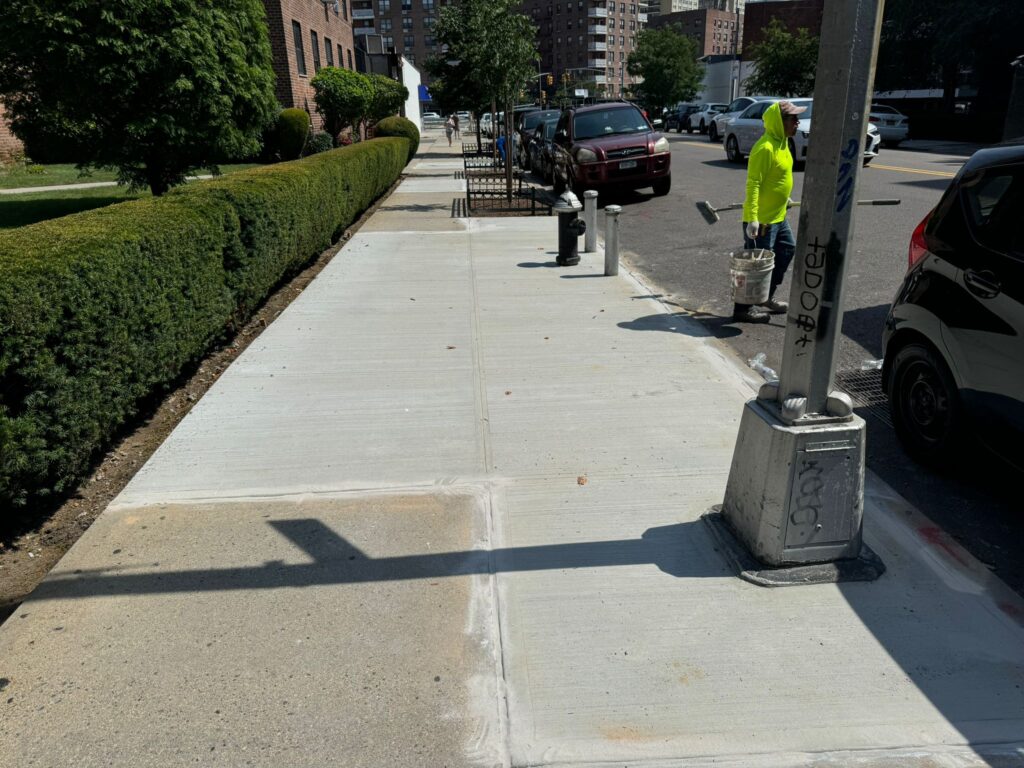
5 Signs You Need a Sidewalk Repair Contractor in NYC Homeowners always take good care of their property and ensure that the space in which they live is comfortable, cozy, and in the best condition. However, one thing owners must understand is that giving importance to the exterior structures of the property is as important as to the interior. Exterior structures, especially the sidewalks adjacent to your property, might need routine inspection and regular maintenance. People use the sidewalks daily but rarely notice the damage to them until someone trips and falls on them or DOT notices the damages and sends a violation notice. We recommend you not wait for the sidewalk damages to escalate and become an issue. You can either detect the issues yourself or hire sidewalk contractors like Sidewalk Repair NYC. Professional experts have years of knowledge, experience, and expertise in fixing your sidewalks. You can check out the sidewalk permit guide by professional sidewalk repair contractors. Here are some signs when you should call a professional sidewalk repair contractor in NYC. Table of Contents Extensive and Deep Cracks Cracks, whether they are minor or major, must be repaired immediately. Usually, cracks in the concrete structure appear when the concrete doesn’t have enough space to expand during the summer season. These cracks can cause rainwater to seep beneath the soil and cause the soil to saturate. Saturated soil can erode and might lead to the sinking of concrete slabs. Detecting sidewalk cracks is easy, as the cracks can be hairline, or deep, like spider webs, or alligator skin. To fix these cracked sidewalks, you can hire the services of professional experts. Depending on the condition of the sidewalks, contractors might repair or replace the concrete slabs. Unevenness of Sidewalk Slabs Uneven sidewalks can cause people to trip and fall. Unevenness in the concrete slabs might occur for many reasons. Sometimes, the tree roots adjacent to the sidewalks might uplift the concrete structure and make the slabs uneven. Other than that, eroded soil can cause the concrete slab to sink and make the surface uneven. For uneven sidewalks, you can hire professional contractors. Experts for sidewalk repairs usually grind the uneven sidewalk slabs with differences less than ¼ inches. However, unevenness between two slabs greater than ¼ inch requires removing the existing slabs, compacting the soil, and installing new slabs. Multiple Potholes Multiple potholes and depressions in your concrete sidewalk slabs show extensive damage to the concrete surface and the soil that must not be ignored. Potholes can occur over time due to numerous reasons, including soil erosion, poor compaction of soil, use of low-quality material while installing the sidewalks, etc. Ignoring potholes on your sidewalks might result in further damage, making your sidewalks dangerous for pedestrians to use. If you notice potholes in the concrete slabs, you must contact professional sidewalk experts like Sidewalk Repair NYC. Experts have the experience and knowledge to assess the extent of the damage and provide cost-effective repair or replacement solutions. Drainage Issues Another big issue that can cause the sidewalks to get damaged is water ponding due to poor drainage or a sloping surface. Drainage issues might seem harmless but standing water can lead to various issues. During the winter, water accumulated in the soil due to poor drainage issues can cause a freeze-thaw cycle and lead to soil erosion. Similarly, during the rainy season, excessive rainwater in the soil can lead to soil erosion. To address this issue, you must consult sidewalk contractors to identify the underlying causes of the pending water issue and get the drainage issue resolved. Timely prevention of extensive water issues can reduce damage to sidewalks and avoid costly future repairs. Damages Due to Tree Roots Tree roots and weed growth in the sidewalks can damage the sidewalk structure over time, Tree roots, in particular, can exert extreme upward pressure on the sidewalks and lead to cracks, upheaval, and other destruction of the sidewalks. To prevent these damages and address the issue of tree root growth, hiring professional sidewalk contractors in NYC is an efficient choice. Professional experts usually hire tree doctors to address the issue of tree root growth. Moreover, they fix the damaged sidewalks and ensure the sidewalks are in good condition at all times. Benefits of Hiring Professional Contractors for Sidewalk Repairs By hiring the expertise of professional experts, you can have peace of mind knowing that professionals are taking care of your sidewalks. There are numerous other reasons why you must trust professional experts for your sidewalks. Qualified contractors possess years of expertise and experience and have essential tools to make efficient repairs. Professional sidewalk experts are licensed and can get permits from NYC DOT for city-compliant sidewalks. Experts are confident about the services they provide and offer warranty and guarantee for the repairs.
How To Get Rid Of DOT Sidewalk Violations?
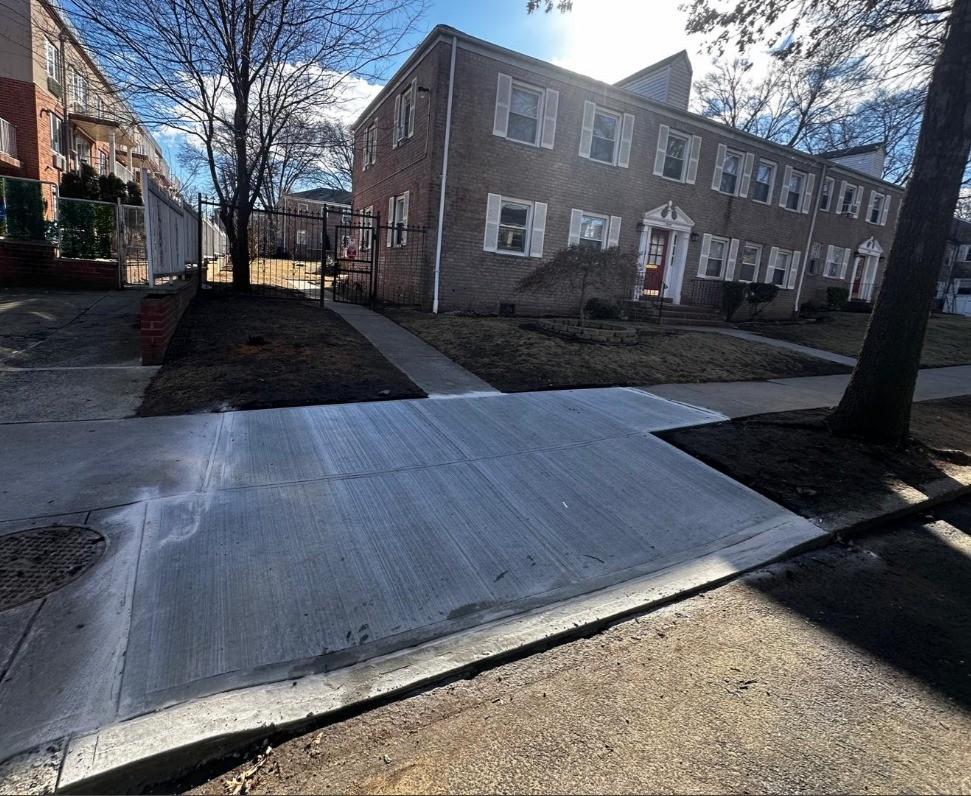
How To Get Rid Of DOT Sidewalk Violations? The NYC DOT has set safety standards and regulations to provide safe and accessible sidewalks for everyone to walk on. Failure to comply with these standards may result in violations. The property owners may receive a violation notice from DOT that means their sidewalks are defective and have a trip hazard for pedestrians. The notice initially informs you that you must resolve the issues within 75 days. However, before you dive deep into the violation notice, you first need to understand the regulations that you have to fulfill to make your sidewalk compliant with safety. Table of Contents What are NYC DOT Regulations? The New York City Administrative Code Section (19-152) states that the property owner is responsible for repairing and maintaining sidewalks in front of their properties to avoid accidents and trip hazards. The DOT expects them to keep sidewalks safe, free of cracks, holes, and other hazardous obstructions that could cause an accident. On the other hand, federal laws, such as the Americans with Disabilities Act (ADA), also establish sidewalk construction guidelines to ensure accessibility for individuals with disabilities. The following requirements must be fulfilled to make your sidewalk ADA-compliant: Minimum sidewalk width must be 36 inches or 3 feet Maximum sidewalk slope must be 1:48, it should not be steeper than 5% The curb ramp must have a slop of 1:12; it should not be steeper than 1:48. Sidewalk Defects That Lead to Violation The DOT inspects the sidewalks regularly. During inspection, if they find any of the following defects, they notify the property owners: Cracks wider than ¼ inch Holes around 1 inch in diameter Raised slabs as little as ½ inch Uneven and sunken slabs Patchwork or hardware that sticks out. Loose, broken or missing slabs Action To Take When Receiving a Notice When you receive a violation notice, do not become stressed. Ensure the validity of the notice before proceeding.You can get help from DOT if you find it invalid. The best way to address your concern is by calling 311 or filling out a DOT complaint form. They can assist you in challenging the notice and protect your rights throughout the process. Seeking Help From Experts If the problems listed in the notice are genuine, you should go for the repair process as early as possible. Consider taking help from a professional contractor who must be licensed from the Department of Consumer and Worker Protection. They are familiar with local regulations and safety guidelines. From inspection to violation dismissal, they handle everything efficiently. Don’t Forget the Permit As per city laws, no sidewalk work should be carried out without a permit from DOT. Even you must get a permit for blocking any part of the sidewalk during the repairs. Any modifications made without city permission lead to fines. Moreover, the city might ask you to remove everything and start over. So ensure that the contractor takes a permit before starting the work. Prioritize Quality Repairs Quality repairs are essential to address sidewalk defects. The quality and strength of the concrete are determined by the PSI (pounds per square inch). The higher the PSI, the more the concrete will be strong and durable. Consider using premium 4000 PSI ready-mix concrete for your sidewalk project to ensure long-lasting and durable resilts. Additionally, utilizing modern repair techniques will help you address the issue in the best possible way while providing sidewalks that withstand the test of time. Communicate with DOT After completing the repairs with a valid sidewalk construction permit, contact DOT and ask for a re-inspection. Their inspector will visit your site and inspect the repairs. If the repair work meets the safety and construction standards, the DOT will dismiss the violations. Conclusion Removing sidewalk violations requires a strategic approach and expert guidance. By acting quickly, hiring a professional contractor, prioritizing quality repairs, and effectively communicating, property owners can successfully remove violations and maintain compliance with NYC regulations. Remember, seeking expert assistance is key to resolving sidewalk violations promptly and working towards the safety and functionality of NYC sidewalks.
5 Common Ways to Fix Uneven Sidewalks
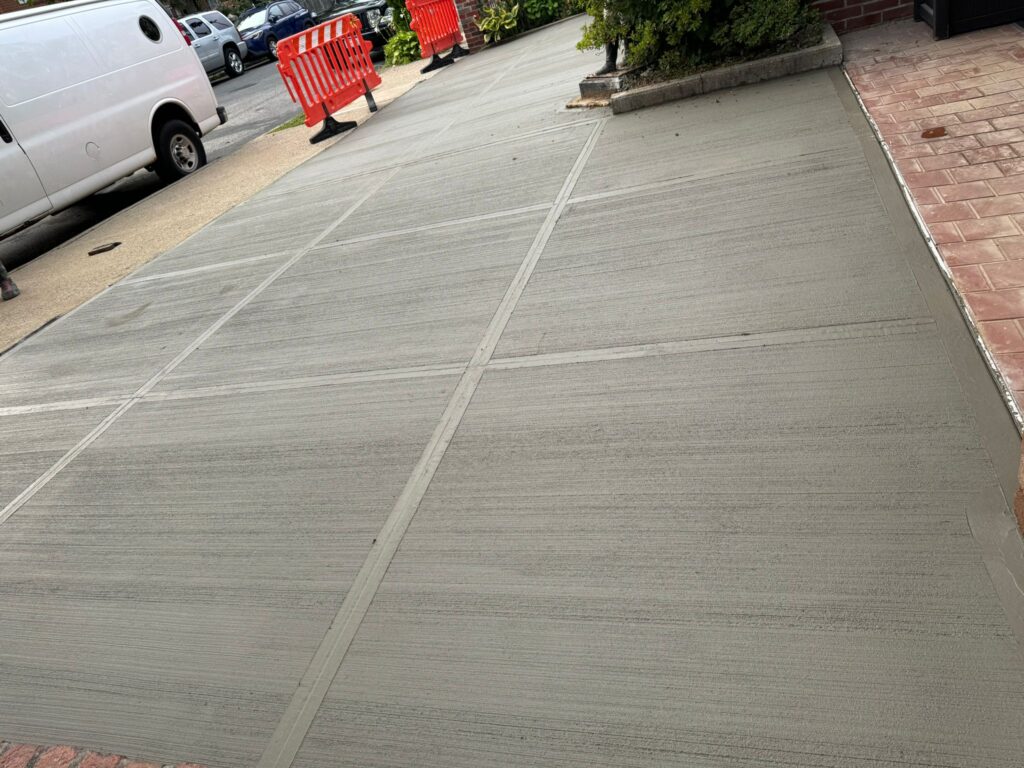
Common Ways to Fix Uneven Sidewalks Uneven sidewalks are a frequent issue for both residential and commercial properties. They not only create safety hazards for pedestrians but also negatively impact the overall appearance of the area. Concrete slabs may settle unevenly over time for a variety of reasons, including shifting soil, tree roots, and poor drainage. These problems may worsen if ignored, resulting in expensive repairs and possible liability issues. Fortunately, several effective methods are available to fix uneven sidewalks, depending on the severity and underlying cause of the problem. Below, we explore some of the most commonly used techniques to restore an even and stable surface. Table of Contents Concrete Slab Lifting (Mudjacking) Slabjacking, another name for mudjacking, is a popular technique for repairing uneven concrete slabs. In order to raise the sunken slab back to its original position, a mixture of cement, water, and other materials is injected beneath it. By filling in the spaces beneath the slab, the injected material stabilizes the soil and repairs the concrete surface. Mudjacking is particularly effective in cases where the soil underneath has compacted or shifted over time. The procedure requires drilling small holes into the concrete, through which the mixture is pumped. Once the material hardens, the slab becomes level again. However, if the soil issues causing the sinking are not addressed, the slab may settle again in the future. Polyurethane Foam Injection (Polyjacking) Polyurethane foam injection, or polyjacking, is a modern alternative to traditional mudjacking. Instead of a heavy slurry mixture, this method uses a lightweight and expanding polyurethane foam to lift the concrete. The foam is injected into the ground through small holes, where it spreads, fills gaps, and hardens, effectively stabilizing the slab. One of the key advantages of polyjacking is that it requires smaller injection holes, making it a less invasive option than mudjacking. Additionally, polyurethane foam cures quickly, allowing for faster repairs and minimal disruption. This method is especially beneficial in areas prone to soil erosion and moisture-related issues, as the foam is water-resistant and provides long-lasting stability. Grinding For minor unevenness, grinding down the raised portions of concrete slabs is a simple and cost-effective solution. This process involves using a specialized grinding machine to level out the height difference between adjacent slabs. It is one of the quickest ways to eliminate trip hazards without undertaking extensive repairs. Grinding is a suitable short-term solution for minor height differences, particularly if a property owner plans to replace the concrete in the near future. However, this method has some drawbacks. Over-grinding can weaken the surface, exposing the pores of the concrete and making it more susceptible to damage from weather conditions and wear. Additionally, grinding can cause discoloration, resulting in an uneven and less aesthetically pleasing appearance. Self-Leveling Concrete Self-leveling concrete is a polymer-modified cement that provides a smooth and even surface without the need for extensive labor. This material is designed to be poured over existing concrete, creating a level finish without requiring traditional troweling. Unlike standard concrete, self-leveling concrete requires less water and dries quickly. It is commonly used for repairing small-scale uneven surfaces and DIY projects. Although it is a great choice for surface enhancements, it is not advised for addressing significant settlement problems or sunken slabs. Furthermore, self-leveling concrete is typically more costly than regular concrete, which makes it impractical for extensive sidewalk repairs. Conclusion Uneven sidewalks are not just an eyesore but also a potential safety hazard. Depending on the extent of damage and the underlying cause, there are a number of efficient ways to fix uneven concrete slabs. Whether using mudjacking, polyjacking, grinding, or self-leveling concrete, selecting the right repair technique is essential to achieving long-lasting results. For the best outcome, consulting a professional is recommended. An expert can assess the condition of the sidewalk and suggest the most suitable repair method. By promptly resolving the issues, property owners can prevent further damage, enhance the value of their property, and ensure safer pathways for pedestrians.
